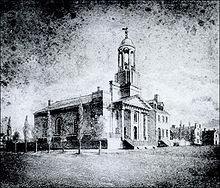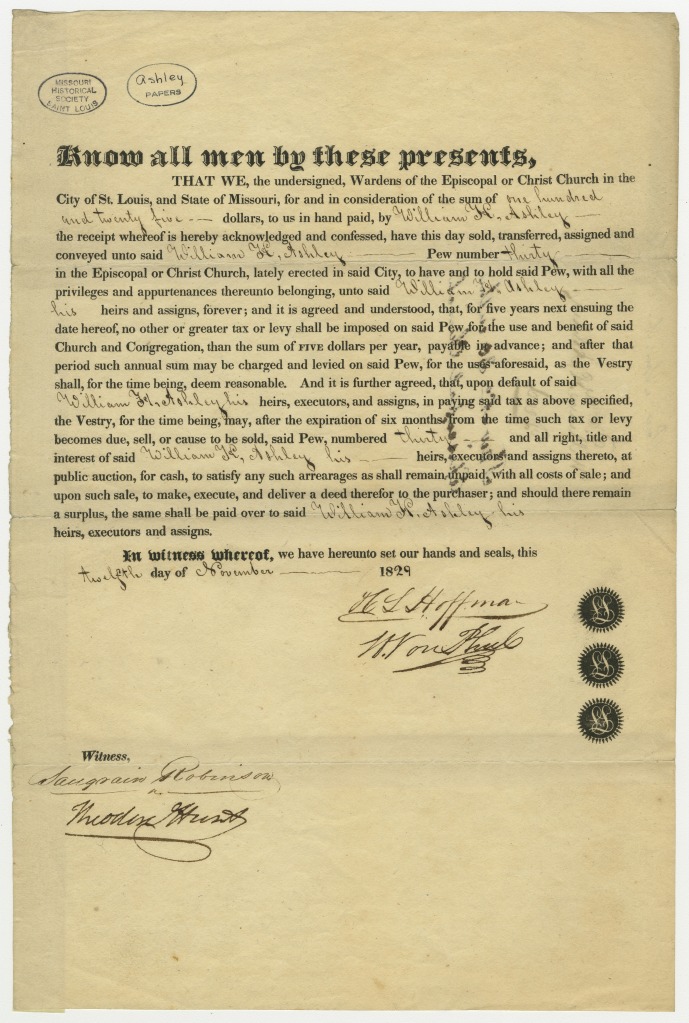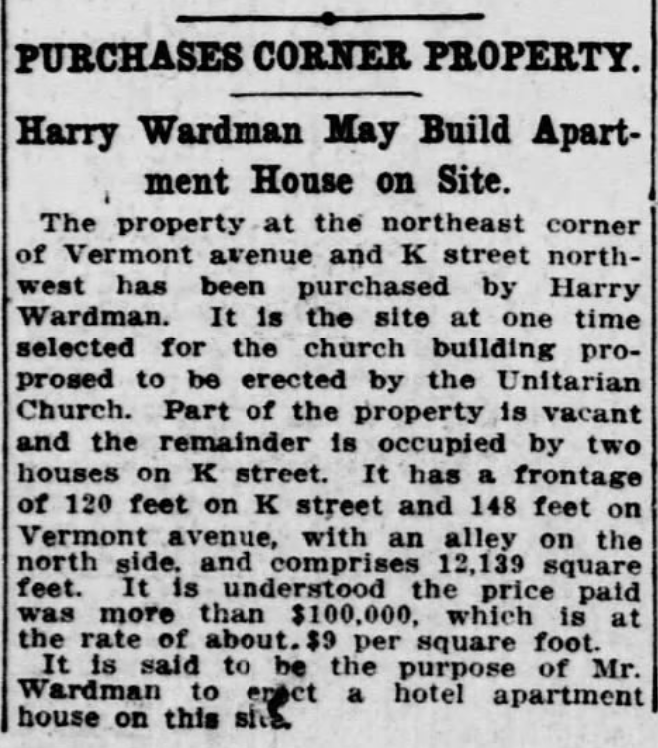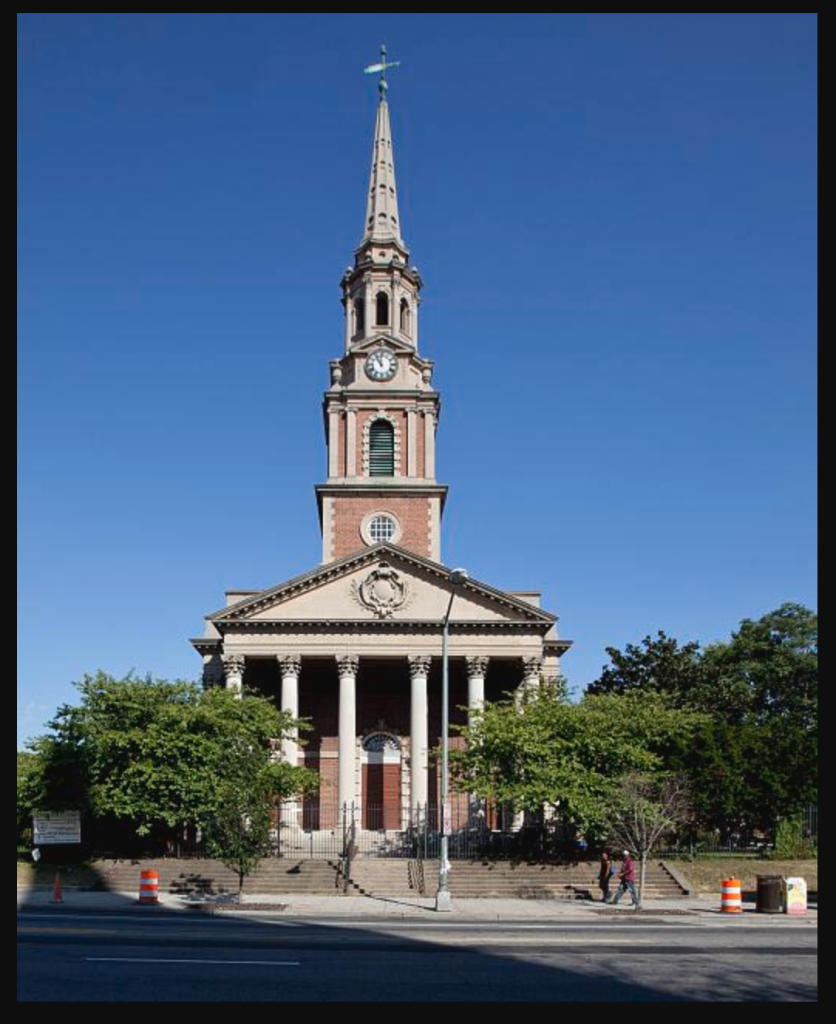At 2835 16th Street, NW stands the All Souls Church, Unitarian, built in 1924. The All Souls Church, originally called the First Unitarian Church, was founded in 1821 by prominent statesmen, politicians, and community leaders of the time, including John Quincy Adams (1767-1848) and John Caldwell Calhoun (1782-1850), who served as President and Vice President of the United States, respectively, from 1825-1829. Founded on democratic principles and advocating for social justice, the church spoke out against slavery well before the abolition of slavery in Washington, DC, in 1862.
1822-1878
Designed by Charles Bulfinch (1763-1844), the third architect of the US Capitol, the first All Souls Church was located at 6th and D Streets, NW (near the present-day H. Carl Moultrie Courthouse).

Prior to the construction of the First Unitarian Church in DC, Unitarian worshippers met in homes and rooms in various locations near and around the city. One of the earliest locations was on Falls Street in Georgetown. (At the time, Georgetown was an independently chartered territory, and upon the passing of the Organic Act of 1871, when the charters of Washington, D.C., and Georgetown were combined, Falls Street was renamed M Street.)

Other locations were in Mr. Rodolph Schaer’s Pestallozzian School on Pennsylvania Avenue, and the Long Room over the Public Baths on C Street.

Wed, Jan 06, 1819 ·Page 3

Thu, Jul 27, 1820 ·Page 1
On July 31, 1820, community members met to discuss constructing a new church building. During that meeting, Thomas Bulfinch (1796-1867), author of Bulfinch’s Mythology and son of Charles Bulfinch (architect), was appointed Secretary of the Unitarian Society. By November 1821, the small congregation of twenty-five members had organized and appointed Robert Little (1762-1827), an English minister who had immigrated to the United States to escape religious restrictions by the Church of England, to be the first pastor of the newly organized First Unitarian Church in D.C. On Sunday, June 9, 1822, the First Unitarian Church opened its doors to the public for the first time.



1878-1924

By the late 1870s, the Sixth & D location had become undesirable due to commercialization. The city’s center was teaming with hotels, cafes, saloons, and shops. The 600-vendor Center Market was only a block away at 7th and Constitution (where the National Archives is today). As urbanization had made the area less than ideal for a house of worship, a new location at the southeast corner of 14th and L Streets, NW, was chosen, and the new church’s cornerstone was laid on June 27, 1877.
As for the Sixth & D building, even though local property owners “raised a howl” and took their objections all the way to the Supreme Court, it was eventually converted and utilized as a police court. The last court session concluded on August 5, 1905, after which the original First Unitarian Church was dismantled.

Source: Library of Congress Prints and Photographs Division’s Online Catalog (public domain image – no copyright restrictions)
Newly organized as the All Souls Church, the new Victorian Gothic-styled building was designed by New Haven architect Rufus Gustavus Russell (1823-1896). The first sermon was delivered on January 24, 1878, followed by a celebratory organ concert and auctioning of the pews.
Auctioning pews was a custom performed by churches during the 17th-19th century whereby parishioners were either assigned, rented or purchased a pew. Monies collected through this process went toward financial support of the church as well as the cost of constructing the pews. Unfortunately, this practice created a perceived social status as the costlier pews were closest to the pulpit.

By 1910, the All Souls Church congregation had grown to approximately 800 members, including prominent figures such as writer, statesman, and abolitionist Frederick Douglass (1817-1895) and William Howard Taft (1857-1930), the 27th president of the United States. Unfortunately, the 14th & L location had only 600 seats, so a new location for the rapidly growing congregation was sought, and the 14th Street building was listed for sale.

Over the next year, the All Souls Church site committee considered several properties in pursuit of a location for the new church. Property on 16th Street between L and M Streets was considered, and in March 1911, the committee set its sights on a property at 16th & Corcoran Streets, NW. However, negotiations for the Corcoran Street property stalled due to the owner’s world travels. In April 1911, the committee purchased four lots at Vermont Avenue and K Street, NW. Upon public announcement of the purchase, President Taft congratulated the committee via telegram and said to the congregation during Sunday services that he believed that the Unitarian doctrine should be spread as it “stands for the broadest principles of Christianity, the brotherhood of man and the Fatherhood of God.”

One year later, in April 1912, the site committee purchased a larger property on 16th Street, directly south of the Scottish Rite Temple located at 1733 16th Street (between R and S Streets) for the new church and parish buildings. The 22,000 sq. ft. 16th Street property cost $101,750. The 12,139 sq. ft. Vermont Avenue property was sold to local architect, Harry Wardman.


By the end of 1912, the congregation had raised $90,000 to aid in the construction of the new edifice. Along with an $85,000 contribution from the American Unitarian Association, the All Souls Church had enough to move forward with construction plans.
Although the construction of the church was not to proceed for some time, the cornerstone ceremonies were hurried along so President Taft could participate before his presidential term ended on March 4, 1913. Accordingly, on February 13, 1913, the Masons, dressed in ceremonial black clothes, silk hats, lambskin aprons, and white gloves, laid the cornerstone for the new church. The trowel used by the Masons to lay the cornerstone was the same trowel used by George Washington on September 18, 1793 to lay the Capitol’s first cornerstone.



Plans for the new Gothic-styled church designed by architectural firm Wood, Donn & Deming were completed in August 1914; however, as with many churches during that time, attention turned to peace efforts and fundraising due to the outbreak of World War I. Once again, plans to build a new church were delayed. In the meantime, services continued at the 14th & L Streets location.

With the end of World War I, sights again turned to the construction of a new church for the growing congregation. In late January 1920, the church committee purchased a lot at 16th and Harvard Streets, NW belonging to Mrs. John B. Henderson, a local real estate investor. Following the finalization of the land purchase, a competition was announced inviting local and national architects to create a design for the new edifice. Among the competitors were George Oakley Totten and the architecture firm Donn & Deming, who designed the church that would have occupied the 16th and R Streets site. The competing architects were requested to create a church design that “typif[ied] the Unitarian ideas and ideals and that they harmonize with the architecture of Washington and fit into the surroundings.” In June 1921, Boston firm, Coolidge and Shattuck, was chosen to design a Georgian-style church with a 165-foot steeple.
The final service at the 14th and L Streets church was held on Sunday, March 14, 1920. One day later, on March 15th, the 42-year-old Victorian Gothic-styled church was razed. To defray costs of building the new church, a commercial office building designed by D.C. architect and building, Arthur W. Brown (1874-1952), was built on the lot and leased to the Buick Motor Company for ten years.
On March 21, 1920, the Knickerbocker Theater at 18th Street and Columbia Road became the temporary home of the All Souls Church while construction of the new church edifice was underway.
This arrangement came to a tragic end on January 28, 1922, after the weight of accumulated snow from a two-day blizzard on the roof of the theater caused a catastrophic collapse, killing 98 people and injuring 133, that were at the theater to watch a silent film. After the collapse, All Souls Church conducted services at the B. F. Keith‘s Theater located at 15th and G Streets, NW.



1924-Present

Source: Library of Congress Prints and Photographs Division’s Online Catalog (public domain image – no copyright restrictions)
After fourteen years and many delays, services at the new church on 16th and Harvard Streets began on April 27, 1924. Interest in the new church was so robust that “hundreds were turned away from the opening service.” The new building’s architectural style was “pure Georgian” and resembled St. Martins-in-the-Fields church, designed by James Gibb (1682-1754) in 1726, located off of Trafalgar Square in London, England.
An official dedication of the new church took place on October 26, 1924. President Calvin Coolidge (1872-1933) and his wife, Grace Goodhue Coolidge (1879-1957) were in attendance, and former President of the United States and Chief Justice William Howard Taft (1857-1930) delivered an address to the congregation.

Over the years, All Souls Church has been at the forefront of social justice and civil rights. Rev. John Little, the first pastor of All Souls’ predecessor, The First Unitarian Church, came to the United States from England to escape religious persecution.
In 1862, abolitionist and women’s rights supporter Rev. William Henry Channing (1810-1884) led the church. Under his guidance, the church was used as a hospital for injured Union soldiers. The congregation gathered in the Senate chambers for church services during this time. And it was Channing’s words, “I am a member of the living family of all souls,” from his discourse entitled “The Father’s Love for Persons,” that was the catalyst for the First Unitarian Church’s 1877 name change to the All Souls Church.
During the 1940s, Rev. A. Powell Davies (1902-1957) advocated for and championed many causes. His sermons addressed diverse topics such as What is an Un-American? (a discourse on the U.S. House of Representative’s Un-American Activities Committee and what it meant to be American), and Lest the Living Forget (a sermon expressing his outrage over the publication of insensitive images after the dropping of atomic bombs on Hiroshima and Nagasaki). In his sermon In Reply to a Letter from Japan, Davies addressed issues raised in a letter from Howard M. Bell, an appointee on Gen. Douglas MacArthur’s Civil Information and Education Section, a war agency devoted to the reconstruction efforts in Japan. In that letter Bell discussed the devastation caused by the the atomic bombs and its affects on Japanese schools. In his sermon, Rev. Davies implored the congregation to collect school supplies which resulted in a one-half ton shipment of supplies for distribution to Japanese school children.
In 1951, Davies was a co-petitioner on a brief that went all the way to the Supreme Court (District of Columbia v. John R. Thomson Co.) challenging the segregation policies of a local restaurant. In 1953, the Supreme Court ruled in favor of petitioners resulting in the desegregation of restaurants in Washington, D.C. In 1954, Davies welcomed the withdrawal of the Metropolitan Police Department’s Boys Club, which held meetings at the church since 1937, saying, “The church cannot accept the club’s policy of segregation.” In May 1955, the first integrated boys club in Washington, D.C., was formed at All Souls Church.
After Davies’s sudden death in 1957, Rev. Duncan Howlett (1906-2003) was called to serve the All Souls Church. Howlett served the congregation for over ten years until his abrupt resignation during his March 24, 1968 sermon. In that sermon, he said, “One of the strongest motives in my stepping down is the conviction that All Souls Church can and should take the lead in integrating the ministry of our Unitarian churches.”
Rev. James Reeb (1927-1965), Howlett’s assistant minister, served All Souls Church from 1959 to 1964. He resigned from his post at All Souls Church to commit fully to the growing civil rights movement. He lost his life at the hands of white supremacists in Selma, Alabama, on March 11, 1966.
Rev. Howlett commemorated Reeb’s life in his book “No Greater Love,” published by Harper & Row in 1966, in which he wrote of Reeb’s spiritual journey. Howlett said, “I felt a sense of excitement retracing the life of a man whose story was the slow development of his mind under the impact of modern knowledge. You saw the deepening and broadening of the man’s social consciousness and the highest religious and moral commitment wholly given to the service of his fellow man.”
In 1969, Rev. David Hilliard Eaton (1932-1992) became the first African American minister of All Souls Church in Washington, DC. Eaton carried on the liberal teachings of Unitarian Universalism by raising awareness of social issues such as “preventive detention” and “no-knock warrants” that were by-products of the “war on drugs” initiated in the 1970s under President Richard Nixon.
Eaton’s service to the community also extended outside of the church. He served as chairman of the D.C. Human Relations Committee and was president of the D.C. Board of Education for three terms. Eaton also hosted WOL AM’s weekly Sunday night call-in show “Speak Up,” which focused on social issues and featured guests such as Stokely Carmichael (1941-1998), a leading figure in the black power movement. The popularity of Eaton’s radio show led to the award-winning “The David Eaton Show,” a weekly NBC (WRC) television interview program that aired from the late 70s to the late 80s. Rev. Eaton died October 21, 1992 from complications due to a liver virus.
All Souls Church has a long history of inspirational leaders and is currently led by Rev. Bill Sinkford, (Transitional Minister), Rev. Rob Keithan (Minister of Social Justice), and Rev. Louise Green (Minister of Congregational Care).
2835 16th Street, NW was designated as an Historic Site in the DC inventory of Historic Sites on November 8, 1964 and listed in the National Register of Historic Places on December 7, 2020. The building is designated as a contributing structure of the Meridian Hill Historic District.

at 2835 16th Street, NW.
For more information about All Souls’ Church and their “progressive religious community” go to https://all-souls.org/about-us/.